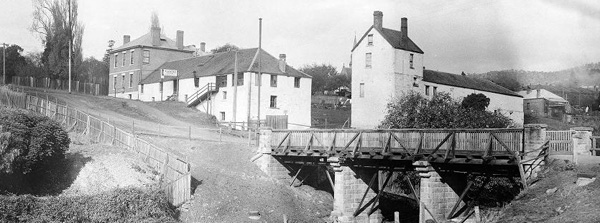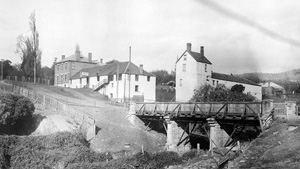
A Brewing Life: William John Disher

Several, perhaps many, of the nineteenth century British brewers who began their Australian careers in Tasmania, soon removed to other colonies. Although the climate of Tasmania was ideally suited to the growth of barley and hops, to malting, and to brewing throughout the year, it was a small community. Greater opportunities awaited on the mainland, especially after the opening of the nearby Port Phillip district, later Victoria. One of those brewers was William John Disher, who remained in the island colony for only about seven years, but that was long enough to leave an indelible impression. His subsequent exploits in Victoria, New South Wales, South Australia and New Zealand were equally remarkable.
Summing up Disher’s career, Deutsher (Breweries of Australia, 1999, p. 159) dismissed him as someone whose ‘brewing experience was minimal’. As the following brief account of his life is intended to show, that assessment is an injustice to a man who designed, built, owned and worked in many breweries in five Australasian colonies over his long career. He did, however, suffer many business failures along the way, and it could fairly be said of him that he was a man never short of big ideas, but who often fell short of realising them.
William John Disher was born in Midlothian, Scotland, in 1822, the son of Robert Disher, the founder of the Edinburgh and Leith Brewery. The exact time and manner of his first arrival in the Australian colonies has not yet been discovered, but he first arrived in Hobart from Sydney late in 1842. There he took over the running of the Albion Brewery in Argyle Street from another young Scot, Andrew Angus. Disher’s beer was well received in Hobart, the Colonial Times considering it to be ‘equal to the best article made by his senior brethren in the trade, and superior to some’.

The Artillery Brewery, Hobart, after its re-erection by William Gracie in the early 1870s, long after William Disher had left it.
After about two years at the Albion Brewery, Disher took new premises in Macquarie Street, Hobart, and opened the Artillery Brewery and Maltings. In September 1847, he was declared insolvent. The matter was resolved in November, when his creditors agreed to accept 5 shillings in the pound. He was almost immediately back in business, but was again declared insolvent in April 1848, in consequence of which the Artillery Brewery was offered for sale or to let. It was continued by Thomas Pascoe, a Cornishman who had come to Hobart in the 1830s, and had worked at the Cascade Brewery in its early years.
Disher and his wife, Elizabeth née Dawson, whom he had married in 1845 soon after starting the Artillery Brewery, moved to Melbourne in 1849. In 1851 he obtained a licence and started in business as a wine and spirit merchant in Collins Street. By 1857 he had become the licensee of the Tattersall’s Hotel in Lonsdale Street.
Around 1860, Disher left Victoria and resettled at Hay, in southern New South Wales. He called his property there Eccles Bank, after the family name of his mother, Jane née Eccles. He attempted to establish a hotel and stock-yards at Eccles Bank, and a punt across the Murrumbidgee River, but was defeated by financial difficulties. His estate was assigned early in 1863, his punt was sold to pay off a mortgagee, and he spent some time confined to gaol at Deniliquin for debt. William’s financial crisis came soon after the death of his younger brother, Thomas, at Eccles Bank in January 1862.
After resolving his troubles at Hay, Disher returned to the brewing business in Victoria, where he entered an arrangement with George Elliot of the Standard Brewery at Echuca. The two came into dispute, from which Disher emerged early in 1865 as the sole owner of the concern. By the end of 1867, Disher was insolvent again, out of business, and living once more in Melbourne.
In 1866, during his brief time at Echuca, Disher promoted a scheme to start a brewery at Deniliquin, in southern New South Wales. He leased four acres of land on which to build the brewery, but withdrew from the field when his former associate at Echuca, George Elliot, started business at Deniliquin and beat him into production.
When John Breheny relinquished the Williamstown Brewery at Williamstown in Victoria in 1868, his successor was Hornby and Co., a partnership between William Hornby and William John Disher, in which Disher was the brewer. Their partnership was of short duration, being dissolved in August 1869. Disher then went to Sydney to take up an appointment as a consultant to the Tooth brothers at their Kent Brewery.
Disher’s stint in Sydney seems to have been among the most successful periods of his brewing career, suggesting that it was not lack of skill as a brewer, but lack of skill as a businessman, that had been the cause of his past failures. Reports of his work at the Kent Brewery, which entailed the replacement of old systems and obsolete equipment with modern appliances, were highly complimentary. One stated that he had ‘worked a most marvellous change in the beer’ and had ‘drawn from the firm an expression of very great satisfaction at the ability and energy displayed by him.’
Soon after completing his engagement at the Kent Brewery, Disher took a trip to the United Kingdom, sailing from Melbourne for London in April 1870. He had returned by August 1872, when he advertised his services as a brewer’s ‘factor’, i.e. agent, in Little Collins Street. In 1873 he tried to promote a scheme to establish a new brewery in Melbourne, to make beer from malt and hops only. He applied for a special grant of land for the purpose, which he argued was a ‘new industry’ for the colony. Ignorant officials, who failed to understand the distinction between Disher’s proposal and the typical colonial breweries of the time which used sugar as a substitute for malt, declined to consider it as a ‘new industry, and told Disher that if he wanted land he must go into the market and buy it. There the matter seems to have rested.
Disher returned to Sydney in mid-1873 to offer his services there, then later the same year went back to Williamstown. He opened Disher’s Hotel there in March 1874, but was insolvent again only a few months later. He went next to Adelaide to assist his son, Alexander Dawson Disher, to resurrect the former Halifax Street Brewery, which had been inoperative for fifteen years. They had it back in operation as the Imperial Brewery by the end of 1874, producing ‘pure malt and hop’ ale and porter in time for Christmas. The brewery had closed by April 1875, when the whole of its stock-in-trade and plant was offered for sale. Also while in Adelaide, Disher designed the Kent Town Brewery for Edwin Smith, construction of which commenced early in 1875.
It was during his sojourn in South Australia that Disher experienced his greatest fall from grace. In what he claimed had been an honest transaction designed to recover money owing to his son, but which the court saw as an act of larceny, in March 1875 Disher had converted to his own use a bill of exchange that belonged to someone else. He was sentenced to be imprisoned for six months with hard labour. Disher asked to be relieved of the hard labour, as he was not fit for it, whereupon the judge agreed to have allotted to him ‘only such work as was suitable to his age [about 53 years] and strength.’
Soon after his release from prison in Adelaide, Disher moved to New Zealand. He resumed his brewing career late in 1877, by taking over the running of the Suffolk Brewery in Christchurch, but sold out a year later. By the end of 1879 he was in New South Wales acting as a judge in the beer section of the Sydney International Exhibition. The conduct of the beer section of the exhibition attracted strong criticism for the fact that the judges were appointed late, and much of the beer had deteriorated in the meantime, and become unfit for competition. There was then a long delay after the awards were made in officially announcing them.
By 1881, Disher had returned to Melbourne, and resumed his business as brewers’ engineer, agent and valuator. His wife, Elizabeth, had remained in New Zealand, and died there in March 1882 after a long illness. After another insolvency early in 1884, Disher was the proponent that year of an ambitious scheme to build a vast new brewery at Mount Macedon, north-west of Melbourne. The most important feature of this brewery was that the beer would be made from malt and hops only, and the use of sugar would be avoided. After inspecting Disher’s plans, the Australian Brewers’ Journal formed the opinion that there was ‘not the smallest chance of such a brewery ever being erected on Mount Macedon’. The opinion was evidently widely held, and the scheme did not proceed.
Apart from financial failure, which followed Disher wherever he went, a feature of his brewing career was his advocacy of brewing without the use of cane sugar or glucose. This was the basis of operation of his proposed breweries in Melbourne (1873) and at Mount Macedon (1884), and of his son’s Imperial Brewery in Adelaide. He wrote in 1882 denigrating the use of glucose in the manufacture of beer. Glucose, or grape sugar, prepared from starch by its chemical treatment with sulphuric acid, was coming into vogue in Victoria at that time as a substitute for malt (or, more correctly, as a substitute for sucrose as a substitute for malt). By the use of such adjuncts, beer could be matured for consumption more speedily, but in Disher’s opinion they produced beer that lacked the fullness of flavour, and was devoid of the keeping qualities of that made from pure malt and hops.
Disher believed that Australia (Tasmania and Victoria) and New Zealand, being climatically well suited to the growth of barley and hops, could become the greatest producing countries in the world for these essential beer-making ingredients. He urged brewers to consider brewing for markets in Asia in competition with English producers. Indeed, that was the idea behind his proposed brewery at Mount Macedon.
After an adverse decision in the Supreme Court in August 1885, Disher was declared insolvent again in September. Little is heard from him from that time onward. The Australian Brewers’ Journal noted briefly in its June 1889 edition that Disher, who was ‘well known amongst the older generation of Australian brewers’, had died ‘recently near Melbourne’, but this report of his demise was premature. He actually met his end in 1893, at the age of 71 years, at Ararat, where he was an inmate in a mental hospital. This was an ignominious exit for a brewer of such energy, creativity and vision.



